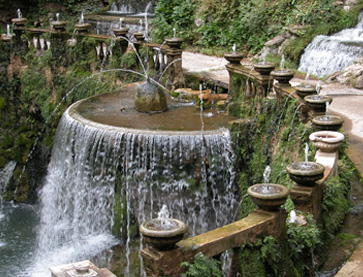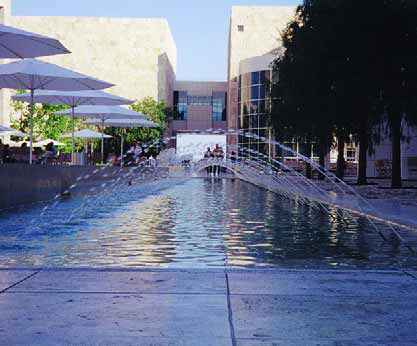Travelogues & History
If you're looking for a destination that includes, all in one place, several of the most enduring and influential watershapes of all time, you couldn't go wrong in visiting Villa d'Este — without question one of the
If you want to gain a full appreciation for classic fountains, pools or waterfeatures, you really do need to pack your bags: Seeing their beauty, power and subtlety at first hand gives us the opportunity to
I grew up in the Phoenix area and have known about Frank Lloyd Wright’s Taliesin West all my life. It was kind of unavoidable: One of the major streets here is named after Wright; the area is marked by examples of architecture that directly reflect his influence; and pretty much everyone in town knows that it was the place Wright used as a summer home while teaching his numerous protégés about his approaches to project design and execution. For my part, however, my closest association with the facility had to do with the fact that my dad routinely delivered produce to the 600-acre facility and often shared stories about the unusual buildings and the occasionally eccentric people he met there. Several decades passed in which I became a watershaper who specializes in contemporary designs, but until quite recently I had never been to Taliesin West. That seems crazy given its vast influence on design in this region, but I made up for my information deficit in a big way last November, after I received a call from a representative of the facility who wanted to speak with me about restoring the facility’s famous
On a recent trip to Spain, Paolo Benedetti and his family took a side-trip to Portugal and happened on some Roman ruins that opened his eyes to a whole new set of possibilities. Here, in a most unusual ‘Solutions’ piece, he describes his encounters with the technologies used to heat an ancient residential indoor swimming pool as well as a collections of pools that made up the public-bath system for a seaside outpost of the Roman Empire. As a pointed expression of the growing global concern over the earth’s changing climate, lots of my clients these days are asking me about alternative methods for heating their pools. It’s a reasonable concern, and I don’t think it will be going away anytime soon. Part of the problem in answering these questions is that neither I nor my clients want to go out on technological limbs and invest in leading-edge or green ideas that have yet to prove themselves. The rest of it probably has to do with the phenomenon of
By now, the thought that watershape and landscape designers need to study nature if they want to replicate it in their projects is basically a cliché. Truly, if you want to mimic nature successfully, you must first know it intimately. What many miss in all this, I believe, is a deeper level of “knowing” that goes well beyond simply observing nature as a source of techniques and ideas. Frankly, I think that as designers and as human beings, we are much better off when we also learn how to become nature – by which I mean letting the sights, sounds and smells draw us physically into the place. In doing so, we engage in experiences so profound that the mere mentioning of that place will set us off with memories we will share enthusiastically – or can use as parts of our latest projects. No matter how often I visit natural places, I’m always amazed at the
In pre-Colonial days, the neck of the woods now known as Longwood Gardens was a hunting ground for the Lenni Lenape tribe, who prized the area for the richness of its game and timber. Once the British arrived, the land moved under the control of William Penn, founder (and namesake) of Pennsylvania, who sold it to a Quaker family by the name of Pierce in the year 1700. The family farmed the property until 1798, when Joshua and Samuel Pierce began planting an arboretum and the space that would one day become Longwood Gardens was born. Those of us living in the Philadelphia area have long enjoyed the privilege of having this resource in nearby Kennett Square, Pa. It's an amazing place, and I find my way there often because it seems that each time I go, there's something
In pre-Colonial days, the neck of the woods now known as Longwood Gardens was a hunting ground for the Lenni Lenape tribe, who prized the area for the richness of its game and timber. Once the British arrived, the land moved under the control of William Penn, founder (and namesake) of Pennsylvania, who sold it to a Quaker family by the name of Pierce in the year 1700. The family farmed the property until 1798, when Joshua and Samuel Pierce began planting an arboretum and the space that would one day become Longwood Gardens was born. Those of us living in the Philadelphia area have long enjoyed the privilege of having this resource in nearby Kennett Square, Pa. It's an amazing place, and I find my way there often because it seems that each time I go, there's something
What’s the use of knowing about history? For many of us, the answer to that question seems so obvious that it comes as a shock to find out just how many people in the watershaping and landscape fields don’t grasp the all-encompassing significance of our collective past – but it shouldn’t. Using my own career as an example – and even though I now spend a considerable amount of my time teaching professionals and university students all about art and architectural history – I confess that I waltzed through more than a few early years as an aspiring landscape architect and watershaper in blissful ignorance of
‘Any time that you can introduce water or the sound of water into an environment, the space is instantly transformed.’ – Geoffrey Lew Rausch, FASLA, 2006 recipient of the Henry Shaw Medal for his work at the Missouri Botanical Garden During the past three decades, the Missouri Botanical Garden has undergone a wonderful transformation, and much of it has been about water. In that span, more than a dozen fountains and waterfeatures have been added to the 79-acre grounds of what many have long been considered to be one of the top three public gardens in the world – and happily, our firm, Hydro Dramatics of St. Louis, has had the privilege of working on all of them as project leaders. These installations have ranged from the simple to the complex. Whether serene or splashing, barely bubbling or shooting skyward, our work has added a unique spirit and drama to many already-beautiful sites. In addition, they’ve involved us in memorable collaborations with the garden’s creative staff, generous sponsors and the more than 850,000 people who come to the garden annually. For our part, the diversity of the watershapes
The history of residential architecture took a real turn toward mass production with the emergence of the modern suburb early in the 20th Century. Especially in the years after World War II, middleclass families increasingly left urban congestion behind and headed for open outlying areas where developers were hard at work in preparation for their arrival. Some developers put distinct stylistic stamps on the neighborhoods and communities they were building. Among the most popular and recognizable of these styles was the Spanish Colonial Revival - a look that has special prominence on the West Coast but that has surfaced throughout the United States and in places as far flung as Europe and China. This style is so popular and has been used so much in so many variations that it is, these days, tough to nail down exactly what is or is not true to early Spanish Colonial motifs and ideas. That's not surprising, because this malleable style itself represents a cobbling together of ideas borrowed from Roman, Islamic and even Native American cultures. Those deep roots, coupled with a scattering of design focus that has blurred borders and distinctions and any sense of stylistic purity, makes it tough for 21st-century watershapers and other designers to





















